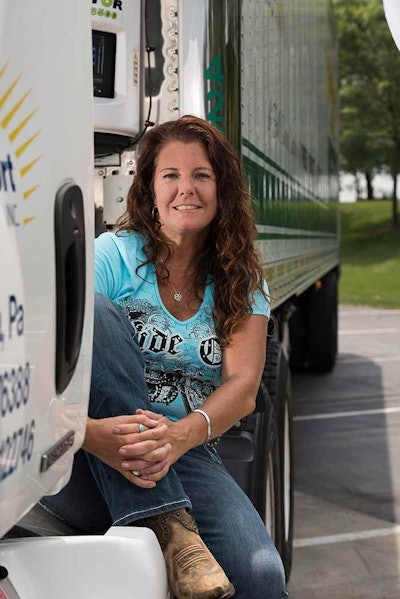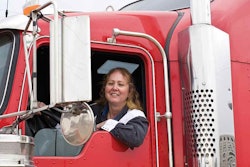
Editor’s note: This is part of the third article in a three-month series examining the driver shortage, measuring its impact on trucking operations and exploring methods to mitigate the crisis.
 One of the best ways to attract more women to driving careers is through positive role models. Joanne Fatta, a driver and trainer for Sunrise Transport, was named Overdrive’s 2015 Most Beautiful and says the subsequent media attention encouraged some young women to enroll in the training school where she teaches.
One of the best ways to attract more women to driving careers is through positive role models. Joanne Fatta, a driver and trainer for Sunrise Transport, was named Overdrive’s 2015 Most Beautiful and says the subsequent media attention encouraged some young women to enroll in the training school where she teaches.Efforts to increase women’s share of the driving workforce have earned less-than-stellar results, barely increasing to 7 percent from 5 percent 10 years ago, according to the U.S. Department of Labor.
That number seemed low to many in the industry, prompting the Women In Trucking association to partner with the National Transportation Institute to develop the Women In Trucking Index, which they say offers a more accurate accounting of the percentage of female drivers. NTI added gender questions to its surveys and in 2016, after a year of data collection, reported the percentage of female drivers at 7.13 percent, which since has climbed to 7.89 percent in the most recent report.
Large carriers that focus on recruiting and retaining women report higher shares, often more than 12 percent and even as much as 30 percent. But in an industry plagued by negative stereotypes of what it means to be a trucker and the challenges many women face in being their family’s primary caretakers, attracting them to driving jobs is an uphill battle.
Best practices from carriers with a high number of female drivers include emphasizing pay and benefits but also spotlighting female trainers, safe equipment and more home time.
Joanne Fatta, a driver and trainer for Ephrata, Pa.-based Sunrise Transport for 18 years, trains female drivers out of CDL school. Many come from retail, food service or other low-paying fields and are searching for financial security. Most heard about trucking through friends and family or through social media hobby and interest groups.

But reaching potential female drivers through social media may not be as simple as running an ad on Pinterest. A recent Facebook survey of Women In Trucking members found 80 percent own or drive motorcycles. “So why not place your recruiting message on a women biker’s forum or chatroom?” asks Ellen Voie, WIT founder and president.

“When female drivers go into their real and virtual communities to tout their profession, that’s an organic marketing pitch you can’t buy with an ad budget.”
— Brooke Mosely, female driver liaison and training specialist, Prime Inc.
Fatta wishes young women would be exposed to the profession earlier and encourages her female drivers to spread the word about the economic advantages of a trucking career. Voie and others have worked on various campaigns to promote trucking to young girls, including reaching out to Girl Scouts, establishing female recognition programs and even creating a plush trucker girl doll.
Stephanie Klang, a retired CFI driver and former captain of the American Trucking Associations’ America’s Road Team, drives her truck to Girl Scout troops in rural areas to help girls earn their transportation patch. Klang emphasizes the economic security she’s earned over the years and how the field, while still predominately male, is gender-blind when it comes to pay.
Beyond pay, respect ranks high as a motivator for all drivers, and women are no different. Katlin Owens, manager of corporate relations for Joplin, Mo.-based CFI, says 14 percent of the company’s drivers are female. “We provide female trainers, and many of our management team are females,” Owens says. “Female drivers have equal footing in driver award criteria.”
Brooke Mosely, female driver liaison and training specialist for Springfield, Mo.-based Prime Inc. (CCJ Top 250, No. 15), says most of the fleet’s nearly 900 female drivers come to Prime via word of mouth. While Prime doesn’t actively target women in its ad campaigns, female drivers account for 12 percent of its drivers, well above the national average.
“Word gets around about how women are treated here,” Mosely says. “When female drivers go into their real and virtual communities to tout their profession, that’s an organic marketing pitch you can’t buy with an ad budget.”














